Pope Leo XIII
Pope Leo XIII (Italian: Leone XIII; born Vincenzo Gioacchino Raffaele Luigi Pecci[lower-alpha 1]; 2 March 1810 – 20 July 1903) was the head of the Catholic Church from 20 February 1878 to his death. He was the oldest pope (reigning until the age of 93), and had the third-longest confirmed pontificate, behind those of Pius IX (his immediate predecessor) and John Paul II.
Leo XIII | |
|---|---|
| Bishop of Rome | |
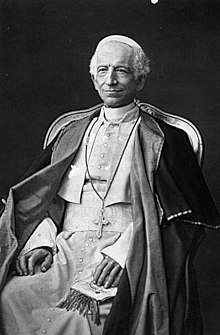 Leo XIII in 1878 | |
| Papacy began | 20 February 1878 |
| Papacy ended | 20 July 1903 |
| Predecessor | Pius IX |
| Successor | Pius X |
| Orders | |
| Ordination | 31 December 1837 by Carlo Odescalchi |
| Consecration | 19 February 1843 by Luigi Lambruschini |
| Created cardinal | 19 December 1853 by Pius IX |
| Personal details | |
| Birth name | Vincenzo Gioacchino Raffaele Luigi Pecci |
| Born | 2 March 1810 Carpineto Romano, département of Rome, French Empire |
| Died | 20 July 1903 (aged 93) Apostolic Palace, Rome, Vatican |
| Previous post |
|
| Signature | |
| Coat of arms |  |
| Other popes named Leo | |
| Papal styles of Pope Leo XIII | |
|---|---|
 | |
| Reference style | His Holiness |
| Spoken style | Your Holiness |
| Religious style | Holy Father |
| Posthumous style | None |
Ordination history of Pope Leo XIII | |||||||||||||||||||||||
|---|---|---|---|---|---|---|---|---|---|---|---|---|---|---|---|---|---|---|---|---|---|---|---|
| |||||||||||||||||||||||
| |||||||||||||||||||||||
He is well known for his intellectualism and his attempts to define the position of the Catholic Church with regard to modern thinking. In his famous 1891 encyclical Rerum novarum, Pope Leo outlined the rights of workers to a fair wage, safe working conditions, and the formation of trade unions, while affirming the rights of property and free enterprise, opposing both socialism and laissez-faire capitalism. He influenced Mariology of the Catholic Church and promoted both the rosary and the scapular.
Leo XIII issued a record of eleven papal encyclicals on the rosary, earning him the title as the "Rosary Pope". In addition, he approved two new Marian scapulars and was the first pope to fully embrace the concept of Mary as Mediatrix. He was the first pope to have never held any control over the Papal States, after they had been dissolved by 1870. He was briefly buried in the grottos of Saint Peter's Basilica before his remains were later transferred to the Basilica of Saint John Lateran.
Early life and education, 1810–1836

Born in Carpineto Romano, near Rome, he was the sixth of the seven sons of Count Ludovico Pecci and his wife, Anna Prosperi Buzzi. His brothers included Giuseppe and Giovanni Battista Pecci. Until 1818, he lived at home with his family "in which religion counted as the highest grace on earth, as through her, salvation can be earned for all eternity."[1] Together with Giuseppe, he studied in the Jesuit College in Viterbo, where he stayed until 1824.[2] He enjoyed Latin and was known to write his own Latin poems at the age of eleven.
In 1824, he and Giuseppe were called to Rome, where their mother was dying. Count Pecci wanted his children near him after the loss of his wife and so they stayed with him in Rome and attended the Jesuit Collegium Romanum.
In 1828, the 18-year-old Vincenzo decided in favour of secular clergy, and Giuseppe entered the Jesuit order.[3] Vincenzo studied at the Academia dei Nobili, mainly diplomacy and law. In 1834, he gave a student presentation, attended by several cardinals, on papal judgments. For his presentation, he received awards for academic excellence and gained the attention of Vatican officials.[4] Cardinal Secretary of State Luigi Lambruschini introduced him to Vatican congregations. During a cholera epidemic in Rome, he assisted Cardinal Sala in his duties as overseer of all the city hospitals.[5] In 1836, he received his doctorate in theology and doctorates of civil and Canon Law in Rome.
Provincial administrator, 1837–1843
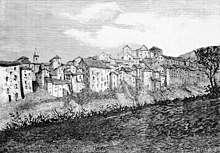
On 14 February 1837, Pope Gregory XVI appointed the 27-year-old Pecci as personal prelate even before he was ordained a priest on 31 December 1837 by the Vicar of Rome, Cardinal Carlo Odescalchi. He celebrated his first Mass with his priest brother Giuseppe.[6] Shortly thereafter, Gregory XVI appointed Pecci as legate (provincial administrator) to Benevento, the smallest papal province, with a population of about 20,000.[5]
The main problems facing Pecci were a decaying local economy, insecurity from widespread bandits, and pervasive Mafia or Camorra structures, which were often allied with aristocratic families. Pecci arrested the most powerful aristocrat in Benevento and his troops captured others, who were either killed or imprisoned by him. With public order restored, he turned to the economy and a reform of the tax system to stimulate trade with the neighboring provinces.[7]
Pecci was first destined for Spoleto, a province of 100,000. On 17 July 1841, he was sent to Perugia with 200,000 inhabitants.[5] His immediate concern was to prepare the province for a papal visitation in the same year. Pope Gregory XVI visited hospitals and educational institutions for several days, asking for advice and listing questions. The fight against corruption continued in Perugia, where Pecci investigated several incidents. When it was claimed that a bakery was selling bread below the prescribed pound weight, he personally went there, had all bread weighed and confiscated it if below legal weight. The confiscated bread was distributed to the poor.[8]
Nuncio to Belgium, 1843
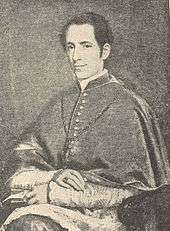
In 1843, Pecci, at only 33, was appointed Apostolic Nuncio to Belgium,[9] a position that guaranteed the Cardinal's hat after completion of the tour.
On 27 April 1843, Pope Gregory XVI appointed Pecci Archbishop and asked his Cardinal Secretary of State Lambruschini to consecrate him.[9] Pecci developed excellent relations with the royal family and used the location to visit neighboring Germany, where he was particularly interested in the resumed construction of the Cologne Cathedral.
In 1844, upon his initiative, a Belgian College in Rome was opened; 102 years later, in 1946, the future Pope John Paul II would begin his Roman studies there. He spent several weeks in England with Bishop Nicholas Wiseman, carefully reviewing the condition of the Catholic Church in that country.[10]
In Belgium, the school question was sharply debated between the Catholic majority and the liberal minority. Pecci encouraged the struggle for Catholic schools, but he was able to win the good will of the Court not only of the pious Queen Louise but also of King Leopold I, who was strongly liberal in his views. The new nuncio succeeded in uniting Catholics. At the end of his mission, the King granted him the Grand Cordon in the Order of Leopold.[11]
Archbishop-Bishop of Perugia, 1846–1878
Papal assistant
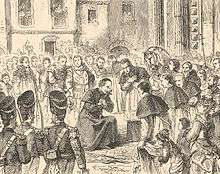
In 1843, Pecci had been named papal assistant. From 1846 to 1877, he was considered a popular and successful Archbishop-Bishop of Perugia. In 1847, after Pope Pius IX granted unlimited freedom for the press in the Papal States,[12] Pecci, who had been highly popular in the first years of his episcopate, became the object of attacks in the media and at his residence.[13] In 1848, revolutionary movements developed throughout Western Europe, including France, Germany and Italy. Austrian, French and Spanish troops reversed the revolutionary gains but at a price for Pecci and the Catholic Church, who could not regain their former popularity.
Provincial council
Pecci called a provincial council to reform the religious life in his dioceses. He invested in enlarging the seminary for future priests and in hiring new and prominent professors, preferably Thomists. He called on his brother Giuseppe Pecci, a noted Thomist scholar, to resign his professorship in Rome and to teach in Perugia instead.[14] His own residence was next to the seminary, which facilitated his daily contacts with the students.
Charitable activities
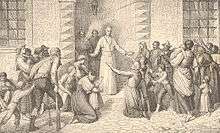
Pecci developed several activities in support of Catholic charities. He founded homeless shelters for boys, girls and elderly women. Throughout his dioceses, he opened branches of a Bank, Monte di Pietà, which focused on low-income people and provided low-interest loans.[15] He created soup kitchens, which were run by the Capuchins. In the consistory of 19 December 1853, he was elevated to the College of Cardinals, as Cardinal-Priest of S. Crisogono.[9] In light of continuing earthquakes and floods, he donated all resources for festivities to the victims. Much of the public attention turned on the conflict between the Papal States and Italian nationalism, which aimed at the Papal States' annihilation to achieve the Unification of Italy.
Defending papacy
Pecci defended the papacy and its claims. When Italian authorities expropriated convents and monasteries of Catholic orders, turning them into administration or military buildings, Pecci protested but acted moderately. When the Italian state took over Catholic schools, Pecci, fearing for his theological seminary, simply added all secular topics from other schools and opened the seminary to nontheologians.[16] The new government also levied taxes on the Church and issued legislation according to which all episcopal or papal utterances were to be approved by the government before their publication.[17]
Organizing First Vatican Council
On 8 December 1869, an ecumenical council, which became known as the First Vatican Council, was to take place in the Vatican per Pope Pius IX. Pecci was likely well informed since the Pope named his brother Giuseppe to help prepare the event.
During the 1870s, in his last years in Perugia, Pecci addressed the role of the Church in modern society several times, defining the Church as the mother of material civilization because it upheld human dignity of working people, opposed the excesses of industrialization and developed large-scale charities for the needy.[18]
In August 1877, on the death of Cardinal Filippo de Angelis, Pope Pius IX appointed him Camerlengo, which required him to reside in Rome.[19]
Papal conclave, 1878
Pope Pius IX died on 7 February 1878,[19] and during his closing years the liberal press had often insinuated that the Kingdom of Italy should take a hand in the conclave and occupy the Vatican. However the Russo-Turkish War (1877–1878) and the sudden death of Victor Emmanuel II (9 January 1878) distracted the government's attention.
In the conclave, the cardinals faced varied questions and discussed issues like church–state relations in Europe, specifically Italy; divisions in the church and the status of the First Vatican Council. It was also debated that the conclave be moved elsewhere, but Pecci decided otherwise. On 18 February 1878, the conclave assembled in Rome. Cardinal Pecci was elected on the third ballot and chose the name Leo XIII.[19] He was announced to the people and later crowned on 3 March 1878.
He retained the administration of the Perugia see until 1880.
Papacy, 1878–1903
| Part of a series on |
| Catholic social teaching |
|---|
 |
| Overview |
|
|
Other figures
|
|
|


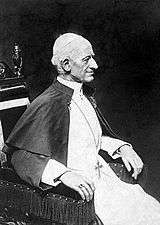
As soon as he was elected to the papacy, Leo XIII worked to encourage understanding between the Church and the modern world. When he firmly reasserted the scholastic doctrine that science and religion coexist, he required the study of Thomas Aquinas[20] and opened the Vatican Secret Archives to qualified researchers, among whom was the noted historian of the Papacy Ludwig von Pastor. He also refounded the Vatican Observatory "so that everyone might see clearly that the Church and her Pastors are not opposed to true and solid science, whether human or divine, but that they embrace it, encourage it, and promote it with the fullest possible devotion."[21]
Leo XIII was the first Pope of whose voice a sound recording was made. The recording can be found on a compact disc of Alessandro Moreschi's singing; a recording of his praying of the Ave Maria is available on the Web.[22] He was also the first Pope to be filmed by a motion picture camera. He was filmed by its inventor, W. K. Dickson, and blessed the camera while being filmed.[23]
Leo XIII brought normality back to the Church after the tumultuous years of Pius IX. Leo's intellectual and diplomatic skills helped regain much of the prestige lost with the fall of the Papal States. He tried to reconcile the Church with the working class, particularly by dealing with the social changes that were sweeping Europe. The new economic order had resulted in the growth of an impoverished working class who had increasing anticlerical and socialist sympathies. Leo helped reverse that trend.
Although Leo XIII was no radical in either theology or politics, his papacy moved the Catholic Church back to the mainstream of European life. Considered a great diplomat, he managed to improve relations with Russia, Prussia, Germany, France, Britain and other countries.
Pope Leo XIII was able to reach several agreements in 1896 that resulted in better conditions for the faithful and additional appointments of bishops. During the fifth cholera pandemic in 1891, he ordered the construction of a hospice inside the Vatican. That building would be torn down in 1996 to make way for construction of the Domus Sanctae Marthae.[24]
Leo was a drinker of the cocaine-infused wine tonic Vin Mariani.[25] He awarded a Vatican gold medal to the wine's creator, Angelo Mariani, and also appeared on a poster endorsing it.[26] Leo XIII was a semi-vegetarian. In 1903, he attributed his longevity to the sparing use of meat and the consumption of eggs, milk and vegetables.[27]
His favourite poets were Virgil and Dante.[28]
Foreign relations
.jpg)
Russia
Pope Leo XIII began his pontificate with a friendly letter to Tsar Alexander II in which he reminded the Russian monarch of the millions of Catholics living in his empire who would like to be good Russian subjects if their dignity were respected.
After the assassination of Alexander II, the Pope sent a high ranking representative to the coronation of his successor, Alexander III, who was grateful and asked for all religious forces to unify. He asked the Pope to ensure that his bishops abstain from political agitation. Relations improved further when Pope Leo XIII, because of Italian considerations, distanced the Vatican from the Rome-Vienna-Berlin alliance, and helped to facilitate a rapprochement between Paris and St. Petersburg.
Germany
Under Otto von Bismarck, the anti-Catholic Kulturkampf in Prussia led to significant restrictions on the Catholic Church in Imperial Germany, including the Jesuits Law of 1872. During Leo's papacy, compromises were informally reached and the anti-Catholic attacks subsided.[29]
The Centre Party in Germany represented Catholic interests and was a force for social change. It was encouraged by Leo's support for social welfare legislation and the rights of working people. Leo's forward-looking approach encouraged Catholic Action in other European countries, where the social teachings of the Church were incorporated into the agenda of Catholic parties, particularly the Christian democratic parties, which became an acceptable alternative to socialist parties. Leo's social teachings were reiterated throughout the 20th century by his successors.
In his Memoirs[30] Kaiser Wilhelm II discussed the "friendly, trustful relationship that existed between me and Pope Leo XIII." During Wilhelm's third visit to Leo: "It was of interest to me that the Pope said on this occasion that Germany must be the sword of the Catholic Church. I remarked that the old Roman Empire of the German nation no longer existed, and that conditions had changed. But he adhered to his words."
France
Leo XIII was the first pope to come out strongly in favour of the French Republic, upsetting many French monarchists.[31]
Italy
In the light of a climate hostile to the Church, Leo continued the policies of Pius IX towards Italy without major modifications.[32] In his relations with the Italian state, Leo continued the Papacy's self-imposed incarceration in the Vatican stance and continued to insist that Italian Catholics should not vote in Italian elections or hold any elected office. In his first consistory in 1879, he elevated his older brother, Giuseppe, to the cardinalate. He had to defend the freedom of the Church against what Catholics considered Italian persecutions and attacks in the area of education, expropriation and violation of Catholic Churches, legal measures against the Church and brutal attacks, culminating in anticlerical groups attempting to throw the body of the deceased Pope Pius IX into the Tiber on 13 July 1881.[33] The Pope even considered moving his residence to Trieste or Salzburg, two cities in Austria, an idea that Emperor Franz Joseph I gently rejected.[34]
United Kingdom
Among the activities of Leo XIII that were important for the English-speaking world, he restored the Scottish hierarchy in 1878. The following year, on 12 May 1879, he raised to the rank of cardinal the convert clergyman John Henry Newman,[35] who would eventually be beatified by Pope Benedict XVI in 2010 and canonized by Pope Francis in 2019. In British India, too, Leo established a Catholic hierarchy in 1886 and regulated some longstanding conflicts with the Portuguese authorities. A Papal Rescript (20 April 1888) condemned the Irish Plan of Campaign and all clerical involvement in it as well as boycotting, followed in June by the papal encyclical "Saepe Nos"[36] that was addressed to all the Irish bishops. Of outstanding significance, not least for the English-speaking world, was Leo's encyclical Apostolicae curae on the invalidity of the Anglican orders, published in 1896. In 1899, he declared St Bede the Venerable a Doctor of the Church.
United States
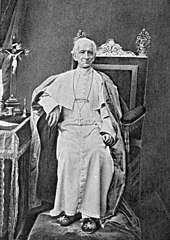
The United States frequently attracted his attention and admiration. He confirmed the decrees of the Third Plenary Council of Baltimore (1884) and raised James Gibbons, the archbishop of that city, to the cardinalate in 1886.
On 10 April 1887, a pontifical charter from Pope Leo XIII founded The Catholic University of America, establishing the national university of the Catholic Church in the United States.
American newspapers criticized Pope Leo because they claimed that he was attempting to gain control of American public schools. One cartoonist drew Leo as a fox unable to reach grapes that were labeled for American schools; the caption read "Sour grapes!"[37]
Brazil
Pope Leo XIII is also remembered for the First Plenary Council of Latin America held at Rome in 1899, and for his encyclical of 1888 to the bishops of Brazil, In plurimis, on the abolition of slavery. In 1897 he published the Apostolic Letter Trans Oceanum, which dealt with the privileges and ecclesiastical structure of the Catholic Church in Latin America.[38]
Chile
During the War of the Pacific, he gave the papal blessing to the Chilean troops on the eve of the Battle of Chorrillos in January 1881; after the battle, in the resulting chaos, there was extensive looting in the city from Chilean troops as well as Peruvians, with the Chileans carrying many old Bibles to their churches.[39] However, one year later, Chilean President Domingo Santa María, a member of the Liberal Party in defiance of the opposition, the fiercely-Catholic Conservative Party, issued the Leyes Laicas (Laic Laws), which reduced the faculties of the church over state and society, though it was not until 1925 that President Arturo Alessandri, also from the Liberal Party separated the church from the state.
Evangelization
Pope Leo XIII sanctioned the missions to Eastern Africa beginning in 1884.[35] In 1879 Catholic missionaries associated with the White Father Congregation (Society of the Missionaries of Africa) came to Uganda and others went to Tanganyika (present day Tanzania) and Rwanda. In 1887, he approved the foundation of Missionaries of St. Charles Borromeo, which were organized by the Bishop of Piacenza, Giovanni Battista Scalabrini. The missionaries were sent to North and South America to do pastoral care for Italian immigrants.
Theology
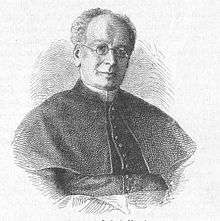
The pontificate of Leo XIII was theologically influenced by the First Vatican Council (1869–1870), which had ended only eight years earlier. Leo XIII issued some 46 apostolic letters and encyclicals dealing with central issues in the areas of marriage and family and state and society. He also wrote two prayers for the intercession of Michael the Archangel after he allegedly had a vision of Michael and the end times,[41] but the story of the alleged vision may be merely apocryphal, as historians note that the story does not appear in any of his writings.[42]
Leo XIII also approved a number of Scapulars. In 1885, he approved the Scapular of the Holy Face, (also known as The Veronica) and elevated the Priests of the Holy Face to an archconfraternity.[43] He also approved the Scapular of Our Lady of Good Counsel and the Scapular of St. Joseph, both in 1893, and the Scapular of the Sacred Heart in 1900.[44]
Thomism
As pope, he used all his authority for a revival of Thomism, the theology of Thomas Aquinas. On 4 August 1879, Leo XIII promulgated the encyclical Aeterni Patris ("Eternal Father"), which, more than any other single document, provided a charter for the revival of Thomism, the medieval theological system based on the thought of Aquinas – as the official philosophical and theological system of the Catholic Church. It was to be normative not only in the training of priests at church seminaries but also in the education of the laity at universities.
Pope Leo XIII then created the Pontifical Academy of St. Thomas Aquinas on 15 October 1879 and ordered the publication of the critical edition, the so-called Leonine Edition, of the complete works of the doctor angelicus. The superintendence of the leonine edition was entrusted to Tommaso Maria Zigliara, professor and rector of the Collegium Divi Thomae de Urbe, the future Pontifical University of Saint Thomas Aquinas, Angelicum. Leo XIII also founded the Angelicum's Faculty of Philosophy in 1882 and its Faculty of Canon Law in 1896.
Consecrations
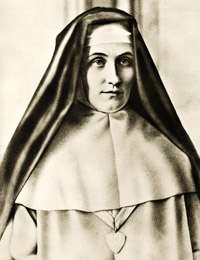
Pope Leo XIII performed a number of consecrations, at times entering new theological territory. After he had received many letters from Sister Mary of the Divine Heart, the countess of Droste zu Vischering and Mother Superior in the Convent of the Good Shepherd Sisters in Porto, Portugal, asking him to consecrate the entire world to the Sacred Heart of Jesus, he commissioned a group of theologians to examine the petition on the basis of revelation and sacred tradition. The outcome of this investigation was positive and so in the encyclical letter Annum sacrum (on 25 May 1899), he decreed that the consecration of the entire human race to the Sacred Heart of Jesus should take place on 11 June 1899.
The encyclical letter also encouraged the entire Catholic episcopate to promote the First Friday Devotions, established June as the Month of the Sacred Heart, and included the Prayer of Consecration to the Sacred Heart.[46] His consecration of the entire world to the Sacred Heart of Jesus presented theological challenges in consecrating non-Christians. Since about 1850, various congregations and countries had consecrated themselves to the Sacred Heart, and, in 1875, the consecration was made throughout the Catholic world.
Scriptures
In his 1893 encyclical Providentissimus Deus, he described the importance of scriptures for theological study. It was an important encyclical for Catholic theology and its relation to the Bible, as Pope Pius XII pointed out 50 years later in his encyclical Divino Afflante Spiritu.[47]
Relations with Eastern Orthodox Churches
Pope Leo XIII fostered relations of goodwill, particularly towards the churches of the East not in communion with the Apostolic See. He also opposed efforts to Latinize the Eastern Rite Churches and stated that they constitute a most valuable ancient tradition and symbol of the divine unity of the Catholic Church. He expressed that in his encyclical "Orientalium Dignitas" of 1894 and wrote, "The Churches of the East are worthy of the glory and reverence that they hold throughout the whole of Christendom in virtue of those extremely ancient, singular memorials that they have bequeathed to us."
Theological research
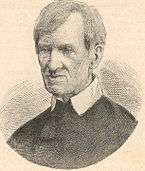
Leo XIII is credited with great efforts in the areas of scientific and historical analysis. He opened the Vatican Archives and personally fostered a 20-volume comprehensive scientific study of the Papacy by Ludwig von Pastor, an Austrian historian.[48]
Mariology
His predecessor, Pope Pius IX, became known as the Pope of the Immaculate Conception because of his dogmatization in 1854. Leo XIII, in light of his unprecedented promulgation of the rosary in 11 encyclicals, was called the Rosary Pope because he promulgated Marian devotion. In his encyclical on the 50th anniversary of the Dogma of the Immaculate Conception, he stresses Mary's role in the redemption of humanity and calls her Mediatrix and Co-Redemptrix. While allowing the title "Mediatrix", recent popes, following on the Second Vatican Council, have warned away from the term "co-redemptrix" as derogating from the one mediator, Jesus Christ.[49][50][51]
Social teachings
Church and state
Leo XIII worked to encourage understanding between the Church and the modern world, but he preferred a cautious view on freedom of thought, stating that it "is quite unlawful to demand, defend, or to grant unconditional freedom of thought, or speech, of writing or worship, as if these were so many rights given by nature to man." Leo's social teachings are based on the Catholic premise that God is the Creator of the world and its Ruler. Eternal law commands the natural order to be maintained, and forbids that it be disturbed; men's destiny is far above human things and beyond the earth.
Rerum novarum
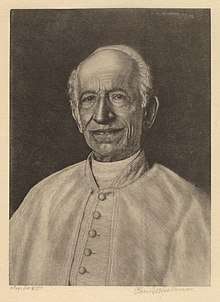
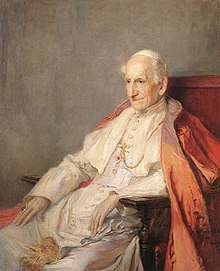
His encyclicals changed the Church's relations with temporal authorities; the 1891 encyclical Rerum novarum, for the first time, addressed social inequality and social justice issues with papal authority by focusing on the rights and duties of capital and labour. He was greatly influenced by Wilhelm Emmanuel von Ketteler, a German bishop who openly propagated siding with the suffering working classes in his book Die Arbeiterfrage und das Christentum. Since Leo XIII, papal teachings have expanded on the rights and obligations of workers and the limitations of private property: Pope Pius XI's Quadragesimo anno, the social teachings of Pope Pius XII on a huge range of social issues, John XXIII's Mater et magistra in 1961, Pope Paul VI's Populorum progressio on world development issues, Pope John Paul II's Centesimus annus, commemorating the 100th anniversary of Rerum novarum, and Pope Francis' Laudato si' on the use of the goods of creation.
Leo had argued that both capitalism and communism are flawed. Rerum novarum introduced the idea of subsidiarity, the principle that political and social decisions should be taken at a local level, if possible, rather than by a central authority, into Catholic social thought. (See list of Encyclicals of Pope Leo XIII.)
Canonizations and beatifications
Leo XIII canonized the following saints during his pontificate:
- 8 December 1881: Clare of Montefalco (d. 1308), John Baptist de Rossi (1696–1764), Lawrence of Brindisi (d. 1619), and Benedict Joseph Labre (1748–1783)
- 15 January 1888: Seven Holy Founders of the Servite Order, Peter Claver (1581–1654), John Berchmans (1599–1621), and Alphonsus Rodriguez (1531–1617)
- 27 May 1897: Antonio Maria Zaccaria (1502–1539) and Peter Fourier (1565–1640)
- 24 May 1900: John Baptist de la Salle (1651–1719) and Rita of Cascia (1381–1457)
Leo XIII beatified several of his predecessors: Urban II (14 July 1881), Victor III (23 July 1887) and Innocent V (9 March 1898). He canonized Adrian III on 2 June 1891.
He also beatified the following:
- Giancarlo Melchiori on 22 January 1882
- Edmund Campion and Ralph Sherwin in 1886
- John Haile on 29 December 1886
- John Baptist de la Salle (whom he later canonized) on 19 February 1888
- Inés of Benigánim on 26 February 1888
- Antonio Maria Zaccaria (whom he later canonized) on 3 January 1890
- Giovanni Giovenale Ancina on 9 February 1890
- Pompilio Maria Pirrotti on 26 January 1890
- Gerard Majella on 29 January 1893
- Leopoldo Croci on 12 May 1893
- Antonio Baldinucci on 16 April 1893
- Rodolfo Acquaviva and 4 Companions on 30 April 1893
- Diego José López-Caamaño on 22 April 1894
- Bernardino Realino on 12 January 1896
- Maria Maddalena Martinengo on 3 June 1900
- Dénis Berthelot of the Nativity and Redento Rodríguez of the Cross on 10 June 1900
- Jeanne de Lestonnac on 23 September 1900
- Antonio Grassi on 30 September 1900
He approved the cult of Cosmas of Aphrodisia. He beatified several of the English martyrs in 1895.[52]
Doctors of the Church
Leo XIII named four individuals as Doctors of the Church:
- Cyril of Alexandria (1883)
- Cyril of Jerusalem (1883)
- John of Damascus (1890)
- Bede the Venerable (13 November 1899)
Audiences
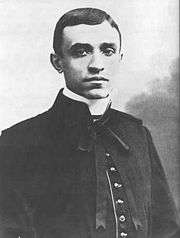
One of the first audiences that Leo XIII granted was to the professors and students of the Collegio Capranica, where in the first row knelt in front of him the young seminarian Giacomo Della Chiesa, the future Pope Benedict XV, who would reign from 1914 to 1922.
On a pilgrimage with her father and sister in 1887, the future Saint Thérèse of Lisieux attended a general audience with Pope Leo XIII and asked him to allow her to enter the Carmelite order. Even though she was strictly forbidden to speak to him because she was told that it would prolong the audience too much, she wrote in her autobiography, Story of a Soul, that after she kissed his slipper and he presented his hand, instead of kissing it, she took it in her own hand and said through tears, "Most Holy Father, I have a great favor to ask you. In honor of your Jubilee, permit me to enter Carmel at the age of 15!" Leo XIII answered, "Well, my child, do what the superiors decide." Thérèse replied, "Oh! Holy Father, if you say yes, everybody will agree!" Finally, the Pope said, "Go... go... You will enter if God wills it" [italics hers]. Two guards lifted her (still on her knees in front of the Pope) by her arms and carried her to the door, where a third gave her a medal of the Pope. Shortly thereafter, the Bishop of Bayeux authorized the prioress to receive Thérèse, and in April 1888, she entered Carmel at the age of 15.
Death

Leo XIII was the first pope to be born in the 19th century and was also the first to die in the 20th century: he lived to the age of 93, dying on 20 July 1903,[53] the longest-lived pope ever (as of 2020). At the time of his death, Leo XIII was the second-longest reigning pope ( 25 years ), exceeded only by his immediate predecessor, Pius IX ( 31 years ).
Charles A. Finn, a priest of the Archdiocese of Boston and at his own death the oldest priest in the United States, served as a Mass officer at his funeral.[54] Leo XIII was entombed in Saint Peter's Basilica only very briefly after his funeral, but was later moved instead to the very ancient Basilica of Saint John Lateran, his cathedral church as the Bishop of Rome, and a church in which he took a particular interest. He was moved there in late 1924.
See also
- Cardinals created by Leo XIII
- Distributism
- Prayer to Saint Michael
- Restoration of the Scottish hierarchy
- List of popes
- Papal Navy
Notes
- [vinˈt͡ʃɛnt͡so d͡ʒoakˈkiːno raffaˈɛːle luˈiːd͡ʒi ˈpett͡ʃi]; English: Vincent Joachim Raphael Lewis Pecci
- Kühne 1880, p. 7.
- Kühne 1880, p. 12.
- Kühne 1880, p. 20.
- Kühne 1880, p. 23.
- "CATHOLIC ENCYCLOPEDIA: Pope Leo XIII". www.newadvent.org.
- Kühne 1880, p. 24.
- Kühne 1880, p. 31.
- Kühne 1880, p. 37.
- Miranda, Salvador. "Pecci, Gioacchino", The Cardinals of the Holy Roman Church
- Kühne 1880, p. 52.
- Laatste Nieuws (Het) 1 January 1910
- Kühne 62
- Kühne 1880, p. 66.
- Kühne 1880, p. 76.
- Kühne 1880, p. 78.
- Kühne 1880, p. 102.
- Kühne 1880, p. 105.
- Kühne 1880, p. 129.
- BERNARD O'REILLY, D. D. (1886). Life of Pope Leo XIII. unknown library.
- Aeterni Patris – On the Restoration of Christian Philosophy (encyclical), Catholic forum, 4 August 1879, archived from the original on 25 February 2007.
- Pecci, Vincenzo Gioacchino Raffaele Luigi (14 March 1891), Ut Mysticam (in Latin).
- Pope Leo XIII, 1810–1910, Archive.
- Abel, Richard (1 August 2004), Encyclopedia of early cinema, p. 266, ISBN 978-0-415-23440-5.
- "Domus Sanctae Marthae & The New Urns Used in the Election of the Pope". EWTN. 22 February 1996. Retrieved 15 February 2010.
- Nesi, Thomas (2008). Poison Pills: The Untold Story of the Vioxx Drug Scandal (1st ed.). New York: Thomas Dunne Books. pp. 53. ISBN 9780312369590. OCLC 227205792.
- Inciardi, James A. (1992). The War on Drugs II. Mayfield Publishing Company. p. 6. ISBN 978-1-55934-016-8.
- The Elusive Secret of Long Life. Arizona Republican. (March 9, 1903). p. 2
- "Pope Leo XIII and his Household" in The Century Illustrated Monthly Magazine, p. 596
- Ross, Ronald J. (1998). The failure of Bismarck's Kulturkampf: Catholicism and state power in imperial Germany, 1871–1887. Washington: Catholic University of America Press. ISBN 978-0-81320894-7.
- Emperor), William I.I. (German (1922). Memoirs. pp. 204–07. Retrieved 23 June 2013.
- "Count Vincenzo Pecci Elected Pope".
- Schmidlin 1934, p. 409.
- Schmidlin 1934, p. 413.
- Schmidlin 1934, p. 414.
- Martire, Egilberto (1951). Enciclopedia Cattolica [Catholic Encyclopedia] (in Italian). 7. Firenze: Casa Editrice G. C. Sansoni.
- Pecci, Vincenzo Gioacchino Raffaele Luigi, Sæpe nos (in Latin), New Advent.
- LLC, CRIA. "CRIA: Commercial Research Image Archives". www.criaimages.com.
- Pecci, Vincenzo Gioacchino Raffaele Luigi (18 April 1897). "Trans Oceanum, Litterae apostolicae, De privilegiis Americae Latinae" [Over the Ocean, Apostolic letter on Latin American privileges] (in Latin). Rome, IT: Vatican. Retrieved 23 June 2013.
- Caivano, Tomas (1907), Historia de la guerra de América entre Chile, Perú y Bolivia [History of the American war between Chile, Peru and Bolivia] (in Spanish).
- Kühne, Benno (1880), Unser Heiliger Vater Papst Leo XIII in seinem Leben und wirken, Benzinger: Einsiedeln, p. 247.
- "Archangel Michael".
- Cekada, Rev. Anthony (1992). "Russia and the Leonine Prayers" (PDF). TraditionalMass.org. Retrieved 29 September 2017.
- Henry Charles Lea, 2002, A History of Auricular Confession and Indulgences in the Latin Church, Adamant Media Corp. ISBN 1-4021-6108-5 page 506
- Francis de Zulueta, 2008, Early Steps In The Fold, Miller Press, ISBN 978-1-4086-6003-4 page 317
- Chasle, Louis (1906), Sister Mary of the Divine Heart, Droste zu Vischering, religious of the Good Shepherd, 1863–1899, London: Burns & Oates.
- Ball, Ann (2003), Encyclopedia of Catholic Devotions and Practices, p. 166, ISBN 978-0-87973-910-2.
- Divino Afflante Spiritu, 1–12.
- von Pastor, Ludwig (1950), Errinnerungen (in German).
- Frederick William Faber (1858). The foot of the Cross; or, The sorrows of Mary. Thomas Richardson and Son. p. 448.
- "Co-Redemptrix as Dogma? : University of Dayton, Ohio". udayton.edu. Retrieved 7 July 2020.
- "Pope Francis on "Co-Redemptrix"". cruxnow.com. Retrieved 7 July 2020.
- "St. Cosmas — Saints & Angels". Catholic Online. Retrieved 15 February 2010.
- John-Peter Pham, Heirs of the Fisherman: Behind the Scenes of Papal Death and Succession, (Oxford University Press, 2004), 98.
- "Monsignor Charles A. Finn, the oldest Roman Catholic priest..." UPI. 8 March 1982. Retrieved 30 January 2019.
References
In English
- Chadwick, Owen. A History of the Popes 1830–1914 (2003). online pp 273–331.
- Chadwick, Owen. The Popes and European Revolution (1981) 655pp excerpt; also online
- Duffy, Eamon (1997), Saints and Sinners, A History of the Popes, Yale University Press.
- Thérèse of Lisieux (1996), Story of a Soul — The Autobiography of St. Thérèse of Lisieux, Clarke, John Clarke trans (3rd ed.), Washington, DC: ICS.
- Quardt, Robert, The Master Diplomat; From the Life of Leo XIII, Wolson, Ilya trans, New York: Alba House.
- O'Reilly, Bernard (1887), Life of Leo XIII — From An Authentic Memoir — Furnished By His Order, New York: Charles L Webster & Co.
In German
- Bäumer, Remigius (1992), Marienlexikon [Dictionary of Mary] (in German), et al, St Ottilien, Eos.
- Franzen, August; Bäumer, Remigius (1988), Papstgeschichte (in German), Freiburg: Herder.
- Kühne, Benno (1880), Papst Leo XIII [Pope Leo XIII] (in German), New York & St. Louis: C&N Benzinger, Einsideln.
- Quardt, Robert (1964), Der Meisterdiplomat [The Master Diplomat] (in German), Kevelaer, DE: Butzon & Bercker
- Schmidlin, Josef (1934), Papstgeschichte der neueren Zeit (in German), München.
In Italian
- Regoli, Roberto (2009). "L'elite cardinalizia dopo la fine dello stato pontificio". Archivum Historiae Pontificiae. 47: 63–87. JSTOR 23565185.
Further reading
- Richard H. Clarke (1903), The Life of His Holiness Leo XIII, Philadelphia: P. W. Ziegler & Co.
External links
| Wikisource has the text of the 1913 Catholic Encyclopedia article Pope Leo XIII. |
| Wikimedia Commons has media related to Leo XIII. |
| Wikisource has original works written by or about: Leo XIII |
| Wikiquote has quotations related to: Pope Leo XIII |
- Pecci, Vincenzo Gioacchino Raffaele Luigi. "Encyclicals and other documents" (Etexts).
- "Pope Leo XIII" (texts & biography). Vatican City: The Vatican.
- "Pope Leo XIII, overview of pontificate". Catholic Community Forum. Archived from the original on 3 June 2004.
- "Pope Leo XIII" (text with concordances and frequency list). Intra text.
- Works by or about Pope Leo XIII at Internet Archive
- Keller, Rev. Joseph E., ed. (1883). Life and Acts of Pope Leo XII (New and Enlarged ed.). New York, Cincinnati, and St. Louis: Benziger Brothers – via Internet Archive.
- Works by Pope Leo XIII at LibriVox (public domain audiobooks)

- Newspaper clippings about Pope Leo XIII in the 20th Century Press Archives of the ZBW
| Diplomatic posts | ||
|---|---|---|
| Preceded by Raffaele Fornari |
Apostolic Nuncio to Belgium 1843–1846 |
Succeeded by Innocenzo Ferrieri |
| Catholic Church titles | ||
| Preceded by Giovanni Giacomo Sinibaldi |
— TITULAR — Archbishop of Tamiathis 1843–1846 |
Succeeded by Diego Planeta |
| Preceded by Carlo Filesio Cittadini |
Archbishop-Bishop of Perugia1 1846–1878 |
Succeeded by Federico Pietro Foschi |
| Preceded by Filippo de Angelis |
Camerlengo of the Holy Roman Church 22 September 1877 – 20 February 1878 |
Succeeded by Camillo di Pietro |
| Preceded by Pius IX |
Pope 20 February 1878 – 20 July 1903 |
Succeeded by Pius X |
| Notes and references | ||
| 1. Retained personal title | ||